check engine Alfa Romeo 4C Spider 2017 Owner's Guide
[x] Cancel search | Manufacturer: ALFA ROMEO, Model Year: 2017, Model line: 4C Spider, Model: Alfa Romeo 4C Spider 2017Pages: 297, PDF Size: 2.84 MB
Page 237 of 297
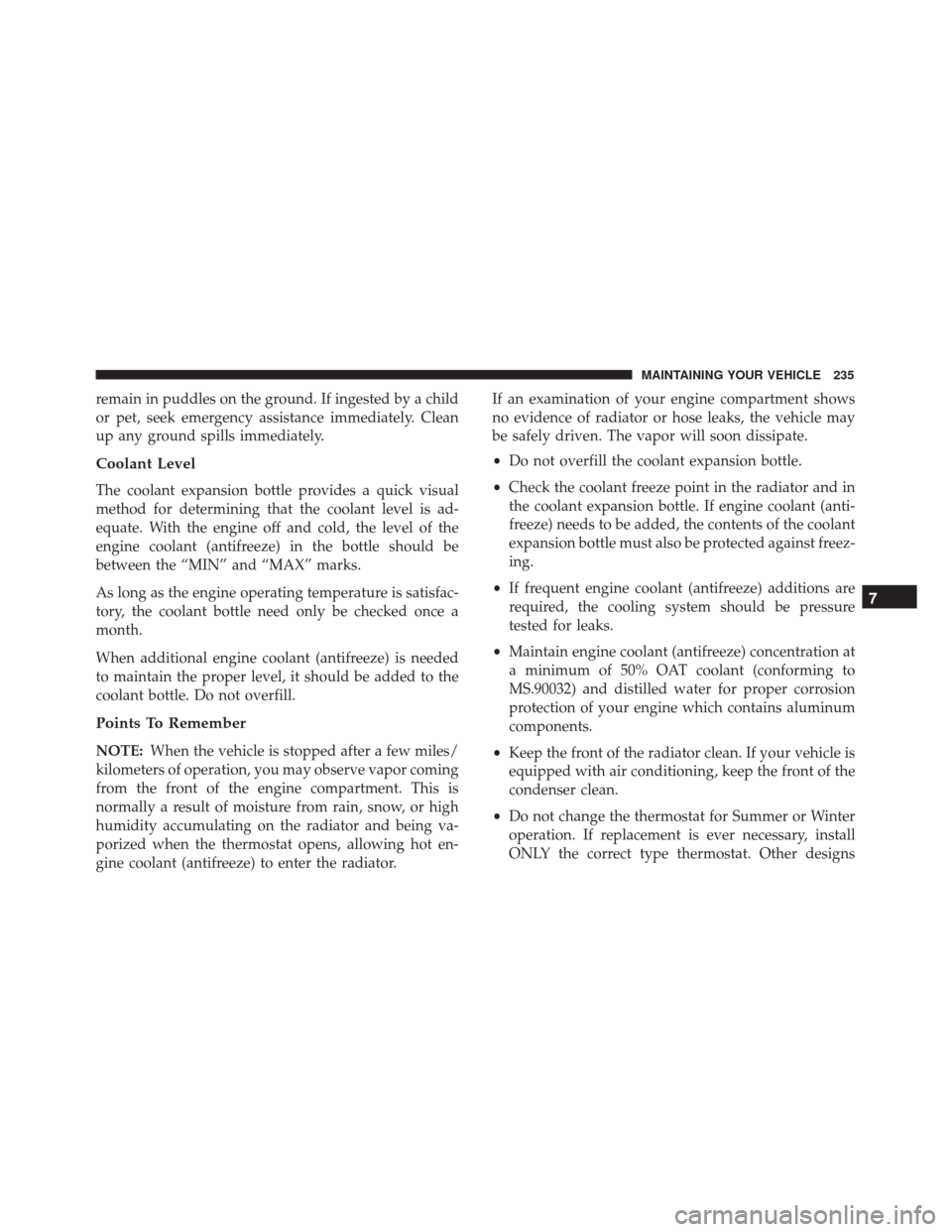
remain in puddles on the ground. If ingested by a child
or pet, seek emergency assistance immediately. Clean
up any ground spills immediately.
Coolant Level
The coolant expansion bottle provides a quick visual
method for determining that the coolant level is ad-
equate. With the engine off and cold, the level of the
engine coolant (antifreeze) in the bottle should be
between the “MIN” and “MAX” marks.
As long as the engine operating temperature is satisfac-
tory, the coolant bottle need only be checked once a
month.
When additional engine coolant (antifreeze) is needed
to maintain the proper level, it should be added to the
coolant bottle. Do not overfill.
Points To Remember
NOTE:When the vehicle is stopped after a few miles/
kilometers of operation, you may observe vapor coming
from the front of the engine compartment. This is
normally a result of moisture from rain, snow, or high
humidity accumulating on the radiator and being va-
porized when the thermostat opens, allowing hot en-
gine coolant (antifreeze) to enter the radiator. If an examination of your engine compartment shows
no evidence of radiator or hose leaks, the vehicle may
be safely driven. The vapor will soon dissipate.
•
Do not overfill the coolant expansion bottle.
• Check the coolant freeze point in the radiator and in
the coolant expansion bottle. If engine coolant (anti-
freeze) needs to be added, the contents of the coolant
expansion bottle must also be protected against freez-
ing.
• If frequent engine coolant (antifreeze) additions are
required, the cooling system should be pressure
tested for leaks.
• Maintain engine coolant (antifreeze) concentration at
a minimum of 50% OAT coolant (conforming to
MS.90032) and distilled water for proper corrosion
protection of your engine which contains aluminum
components.
• Keep the front of the radiator clean. If your vehicle is
equipped with air conditioning, keep the front of the
condenser clean.
• Do not change the thermostat for Summer or Winter
operation. If replacement is ever necessary, install
ONLY the correct type thermostat. Other designs
7
MAINTAINING YOUR VEHICLE 235
Page 238 of 297
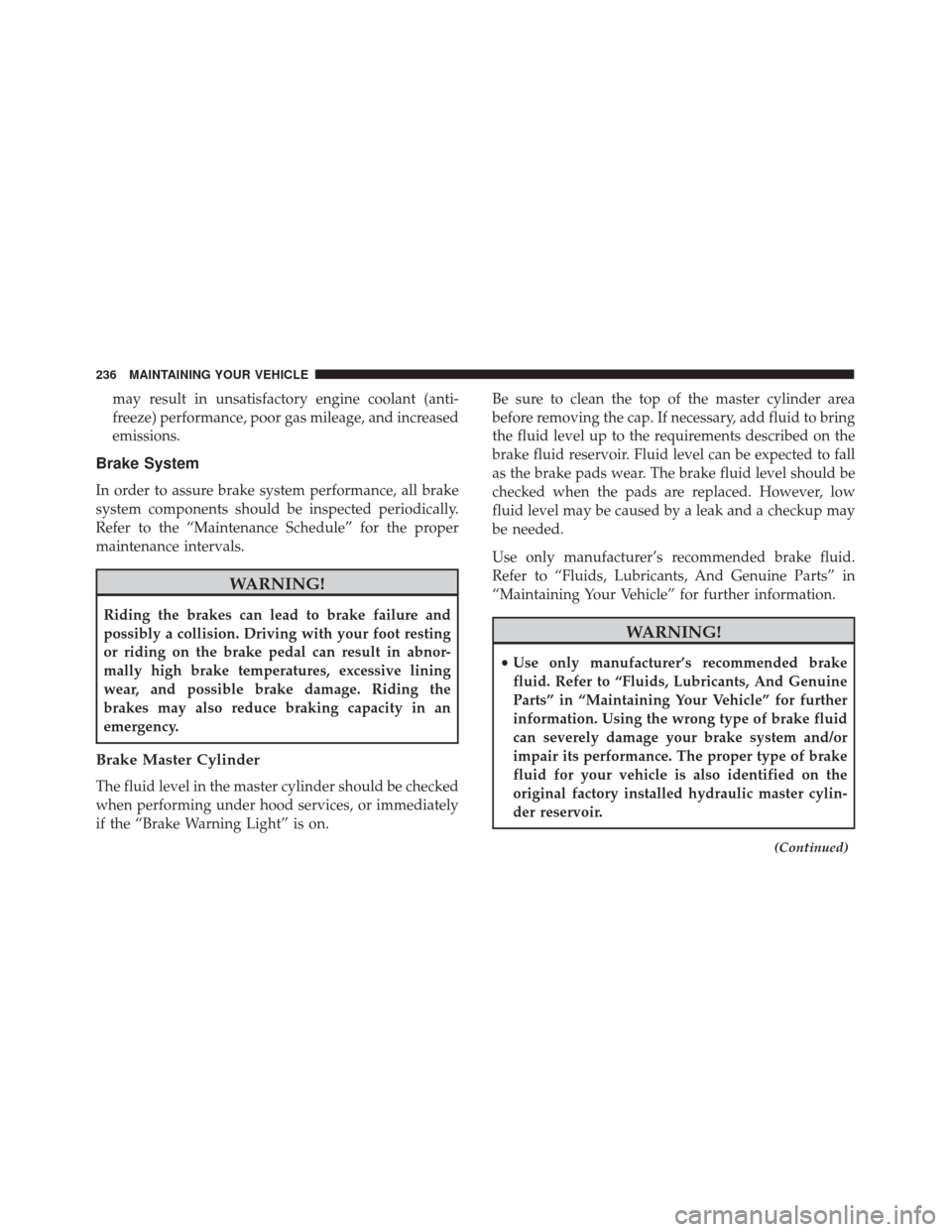
may result in unsatisfactory engine coolant (anti-
freeze) performance, poor gas mileage, and increased
emissions.
Brake System
In order to assure brake system performance, all brake
system components should be inspected periodically.
Refer to the “Maintenance Schedule” for the proper
maintenance intervals.
WARNING!
Riding the brakes can lead to brake failure and
possibly a collision. Driving with your foot resting
or riding on the brake pedal can result in abnor-
mally high brake temperatures, excessive lining
wear, and possible brake damage. Riding the
brakes may also reduce braking capacity in an
emergency.
Brake Master Cylinder
The fluid level in the master cylinder should be checked
when performing under hood services, or immediately
if the “Brake Warning Light” is on.Be sure to clean the top of the master cylinder area
before removing the cap. If necessary, add fluid to bring
the fluid level up to the requirements described on the
brake fluid reservoir. Fluid level can be expected to fall
as the brake pads wear. The brake fluid level should be
checked when the pads are replaced. However, low
fluid level may be caused by a leak and a checkup may
be needed.
Use only manufacturer’s recommended brake fluid.
Refer to “Fluids, Lubricants, And Genuine Parts” in
“Maintaining Your Vehicle” for further information.
WARNING!
•
Use only manufacturer’s recommended brake
fluid. Refer to “Fluids, Lubricants, And Genuine
Parts” in “Maintaining Your Vehicle” for further
information. Using the wrong type of brake fluid
can severely damage your brake system and/or
impair its performance. The proper type of brake
fluid for your vehicle is also identified on the
original factory installed hydraulic master cylin-
der reservoir.
(Continued)
236 MAINTAINING YOUR VEHICLE
Page 239 of 297
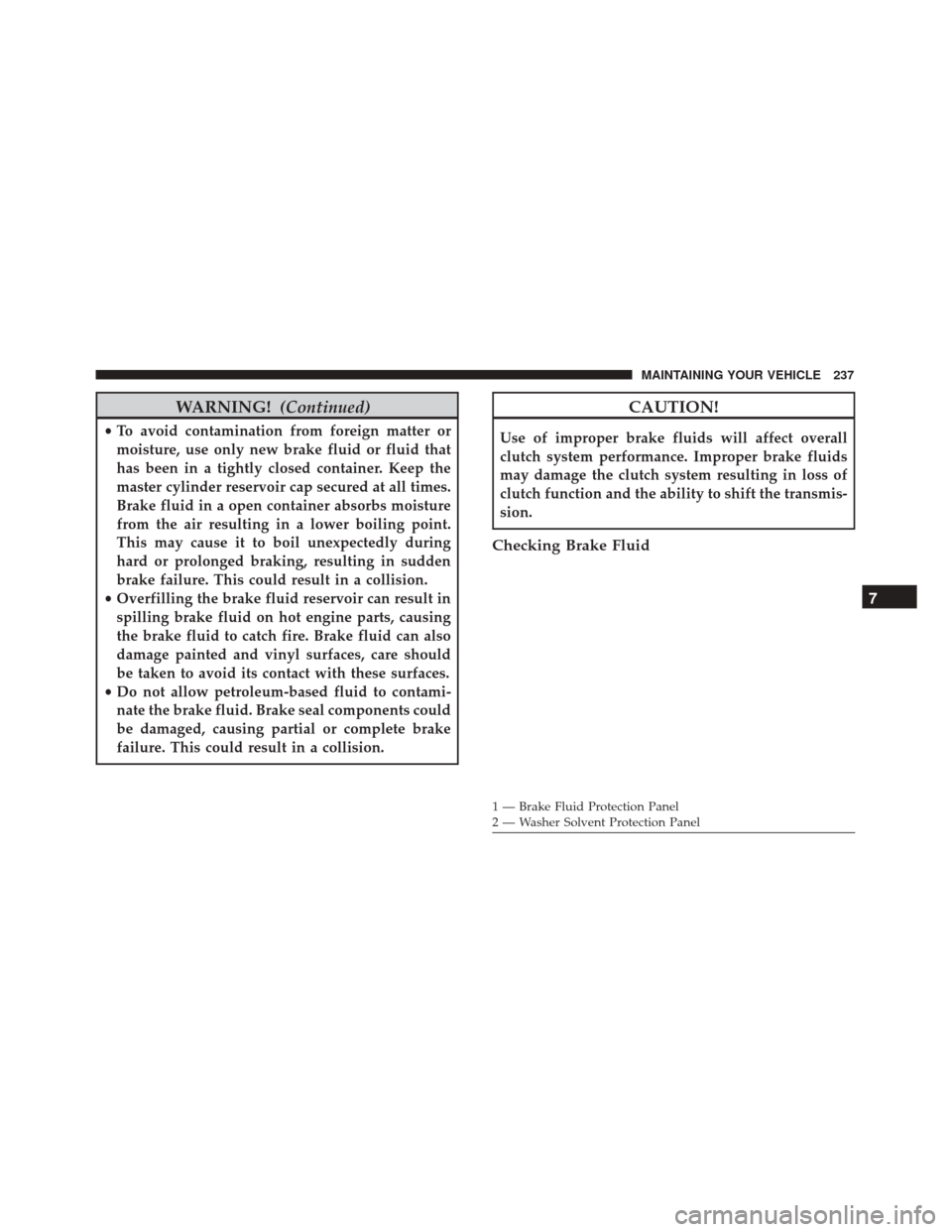
WARNING!(Continued)
•To avoid contamination from foreign matter or
moisture, use only new brake fluid or fluid that
has been in a tightly closed container. Keep the
master cylinder reservoir cap secured at all times.
Brake fluid in a open container absorbs moisture
from the air resulting in a lower boiling point.
This may cause it to boil unexpectedly during
hard or prolonged braking, resulting in sudden
brake failure. This could result in a collision.
• Overfilling the brake fluid reservoir can result in
spilling brake fluid on hot engine parts, causing
the brake fluid to catch fire. Brake fluid can also
damage painted and vinyl surfaces, care should
be taken to avoid its contact with these surfaces.
• Do not allow petroleum-based fluid to contami-
nate the brake fluid. Brake seal components could
be damaged, causing partial or complete brake
failure. This could result in a collision.
CAUTION!
Use of improper brake fluids will affect overall
clutch system performance. Improper brake fluids
may damage the clutch system resulting in loss of
clutch function and the ability to shift the transmis-
sion.
Checking Brake Fluid
1 — Brake Fluid Protection Panel
2 — Washer Solvent Protection Panel
7
MAINTAINING YOUR VEHICLE 237
Page 271 of 297
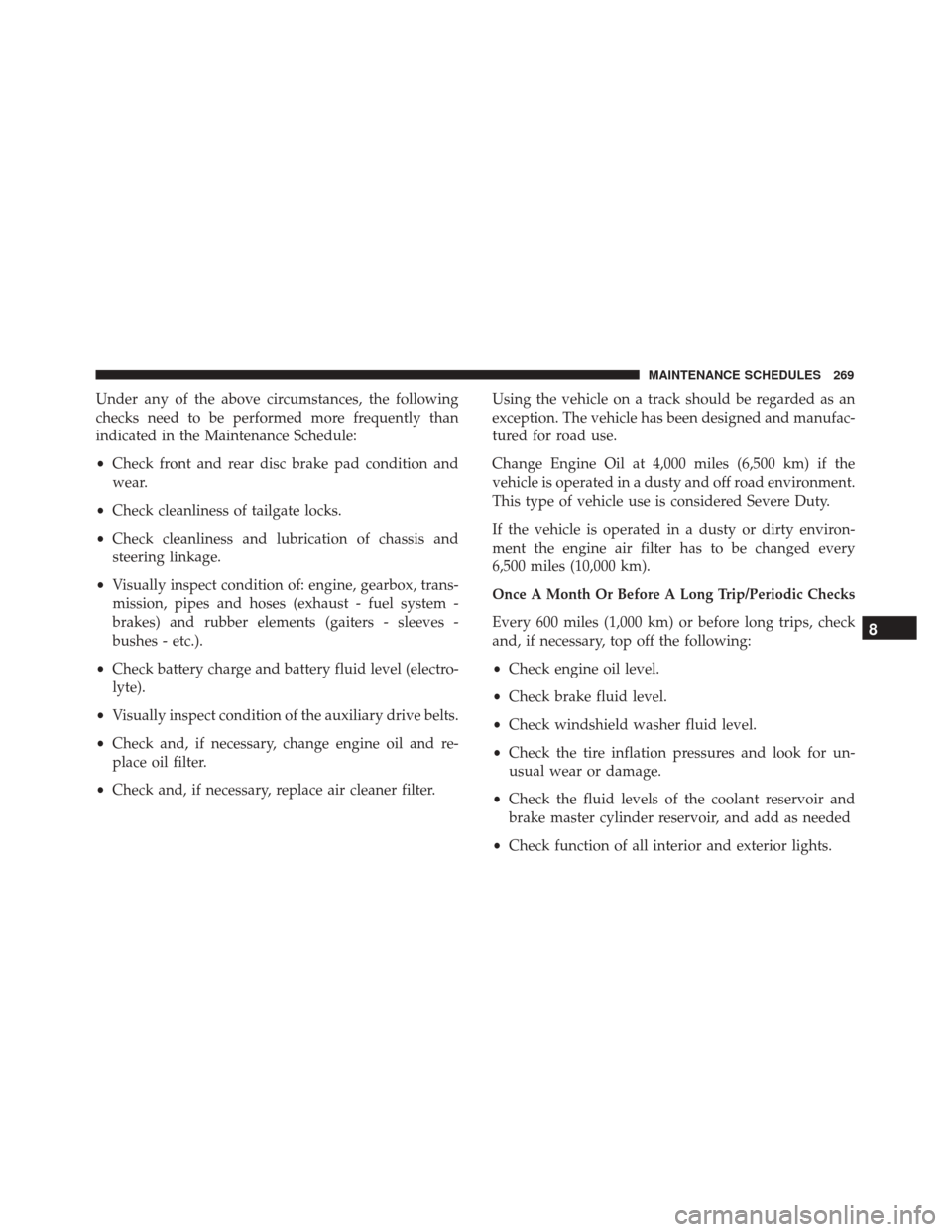
Under any of the above circumstances, the following
checks need to be performed more frequently than
indicated in the Maintenance Schedule:
•Check front and rear disc brake pad condition and
wear.
• Check cleanliness of tailgate locks.
• Check cleanliness and lubrication of chassis and
steering linkage.
• Visually inspect condition of: engine, gearbox, trans-
mission, pipes and hoses (exhaust - fuel system -
brakes) and rubber elements (gaiters - sleeves -
bushes - etc.).
• Check battery charge and battery fluid level (electro-
lyte).
• Visually inspect condition of the auxiliary drive belts.
• Check and, if necessary, change engine oil and re-
place oil filter.
• Check and, if necessary, replace air cleaner filter. Using the vehicle on a track should be regarded as an
exception. The vehicle has been designed and manufac-
tured for road use.
Change Engine Oil at 4,000 miles (6,500 km) if the
vehicle is operated in a dusty and off road environment.
This type of vehicle use is considered Severe Duty.
If the vehicle is operated in a dusty or dirty environ-
ment the engine air filter has to be changed every
6,500 miles (10,000 km).
Once A Month Or Before A Long Trip/Periodic Checks
Every 600 miles (1,000 km) or before long trips, check
and, if necessary, top off the following:
•
Check engine oil level.
• Check brake fluid level.
• Check windshield washer fluid level.
• Check the tire inflation pressures and look for un-
usual wear or damage.
• Check the fluid levels of the coolant reservoir and
brake master cylinder reservoir, and add as needed
• Check function of all interior and exterior lights.8
MAINTENANCE SCHEDULES 269
Page 272 of 297
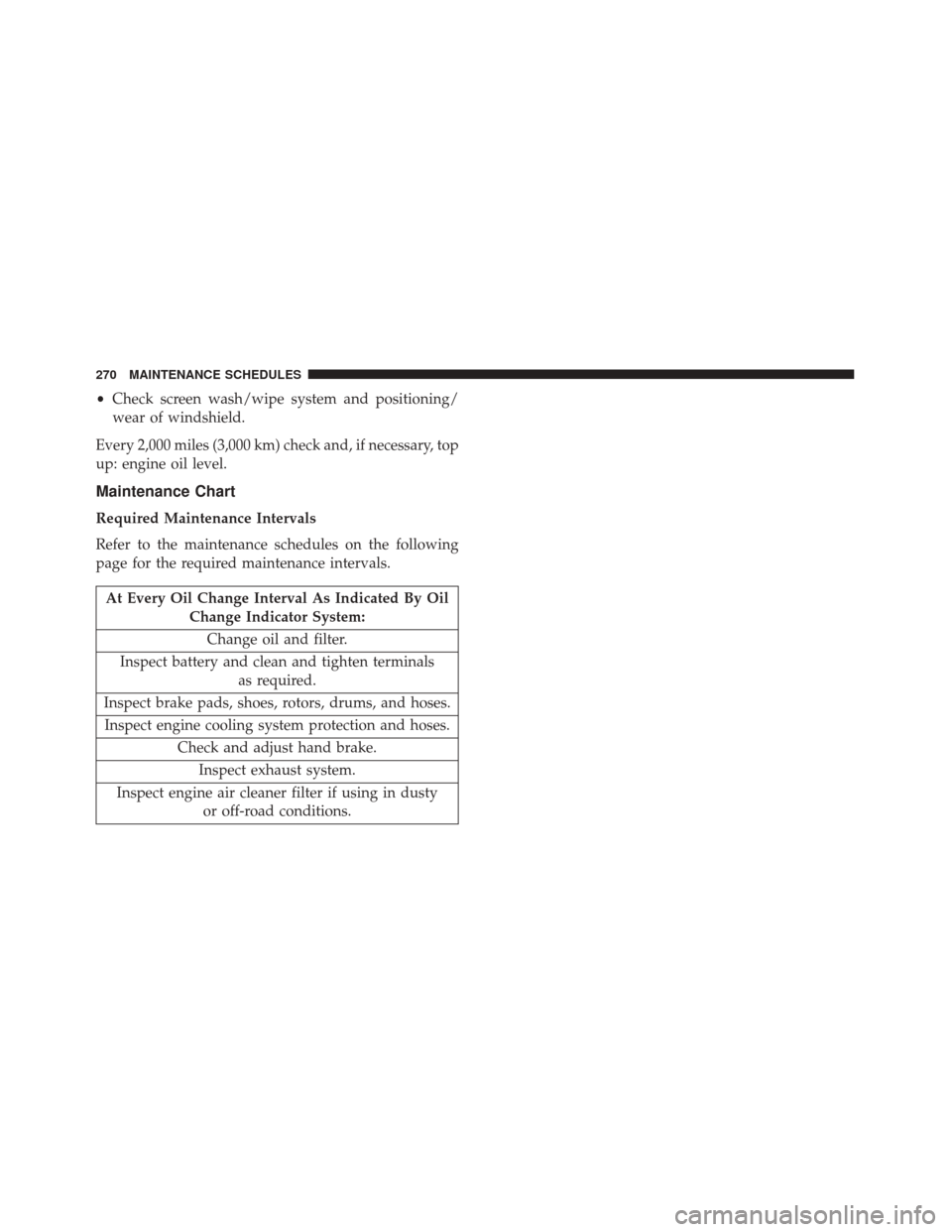
•Check screen wash/wipe system and positioning/
wear of windshield.
Every 2,000 miles (3,000 km) check and, if necessary, top
up: engine oil level.
Maintenance Chart
Required Maintenance Intervals
Refer to the maintenance schedules on the following
page for the required maintenance intervals.
At Every Oil Change Interval As Indicated By Oil Change Indicator System:
Change oil and filter.
Inspect battery and clean and tighten terminals as required.
Inspect brake pads, shoes, rotors, drums, and hoses. Inspect engine cooling system protection and hoses. Check and adjust hand brake.Inspect exhaust system.
Inspect engine air cleaner filter if using in dusty or off-road conditions.
270 MAINTENANCE SCHEDULES
Page 275 of 297
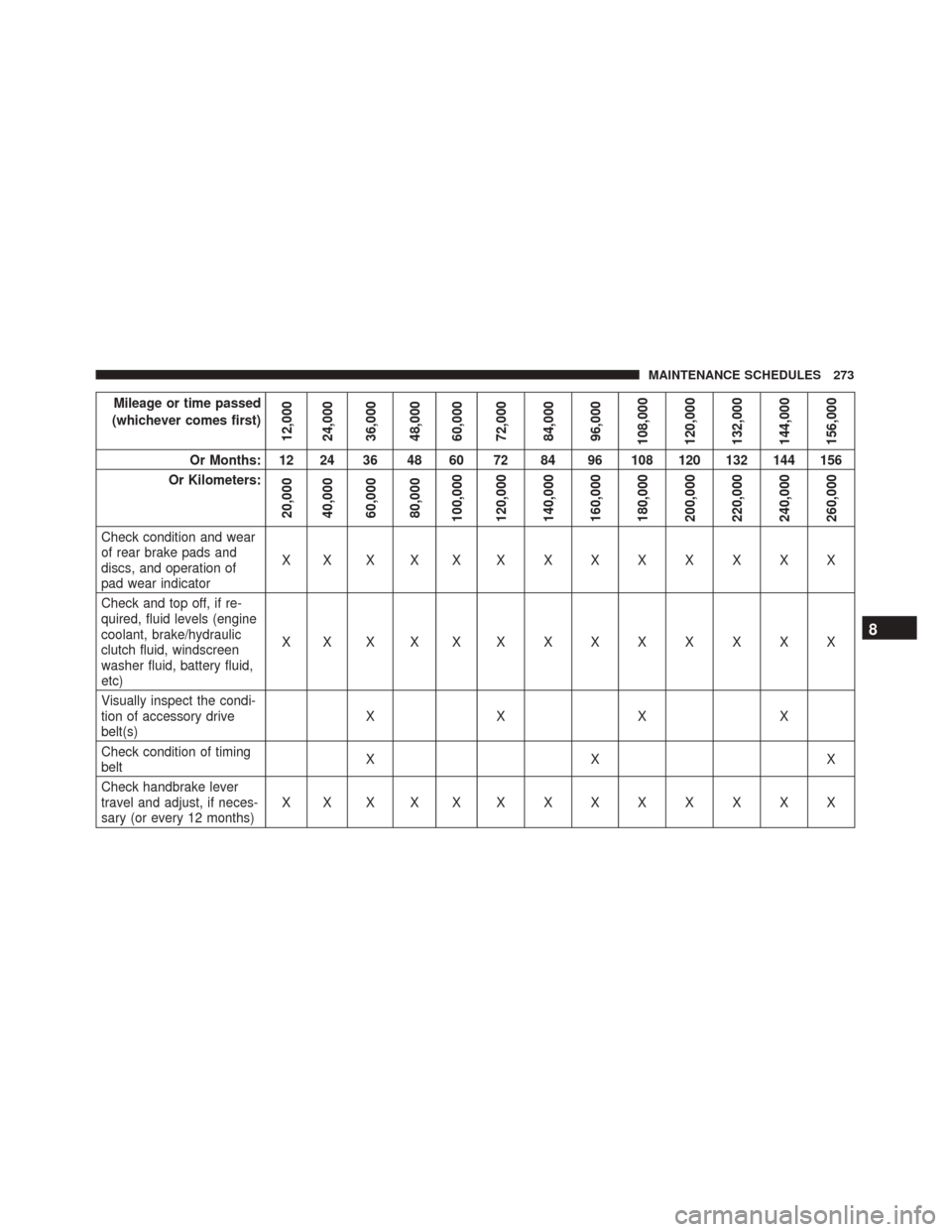
Mileage or time passed
(whichever comes first)
12,000
24,000
36,000
48,000
60,000
72,000
84,000
96,000
108,000
120,000
132,000
144,000
156,000
Or Months: 12 24 36 48 60 72 84 96 108 120 132 144 156
Or Kilometers:
20,000
40,000
60,000
80,000
100,000
120,000
140,000
160,000
180,000
200,000
220,000
240,000
260,000
Check condition and wear
of rear brake pads and
discs, and operation of
pad wear indicator XXXXXXXXXXXXX
Check and top off, if re-
quired, fluid levels (engine
coolant, brake/hydraulic
clutch fluid, windscreen
washer fluid, battery fluid,
etc) XXXXXXXXXXXXX
Visually inspect the condi-
tion of accessory drive
belt(s) XX X X
Check condition of timing
belt XX X
Check handbrake lever
travel and adjust, if neces-
sary (or every 12 months) XXXXXXXXXXXXX
8
MAINTENANCE SCHEDULES 273
Page 276 of 297
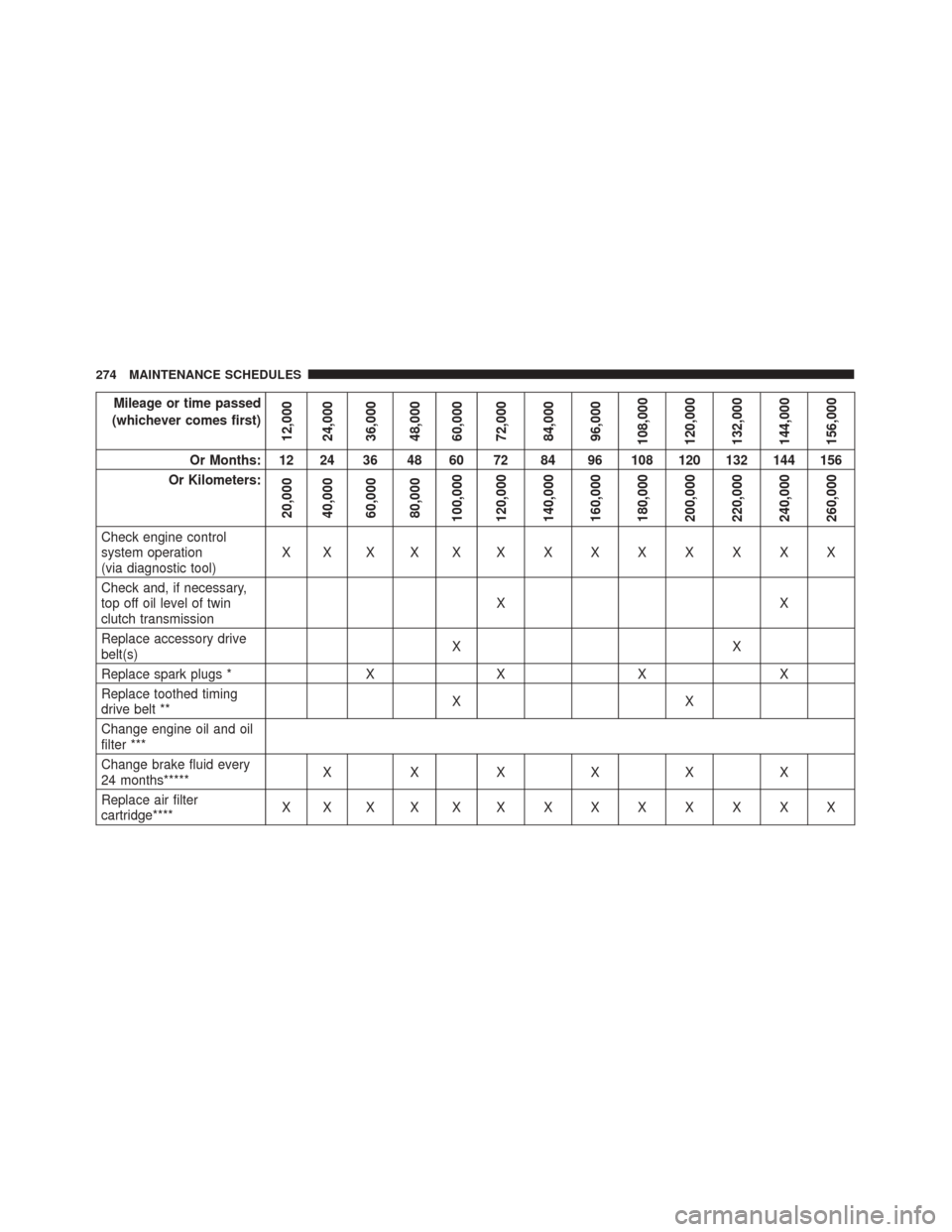
Mileage or time passed
(whichever comes first)
12,000
24,000
36,000
48,000
60,000
72,000
84,000
96,000
108,000
120,000
132,000
144,000
156,000
Or Months: 12 24 36 48 60 72 84 96 108 120 132 144 156
Or Kilometers:
20,000
40,000
60,000
80,000
100,000
120,000
140,000
160,000
180,000
200,000
220,000
240,000
260,000
Check engine control
system operation
(via diagnostic tool) XXXXXXXXXXXXX
Check and, if necessary,
top off oil level of twin
clutch transmission XX
Replace accessory drive
belt(s) XX
Replace spark plugs * X X X X
Replace toothed timing
drive belt ** XX
Change engine oil and oil
filter ***
Change brake fluid every
24 months***** XXX X X X
Replace air filter
cartridge**** XXXXXXXXXXXXX
274 MAINTENANCE SCHEDULES
Page 277 of 297
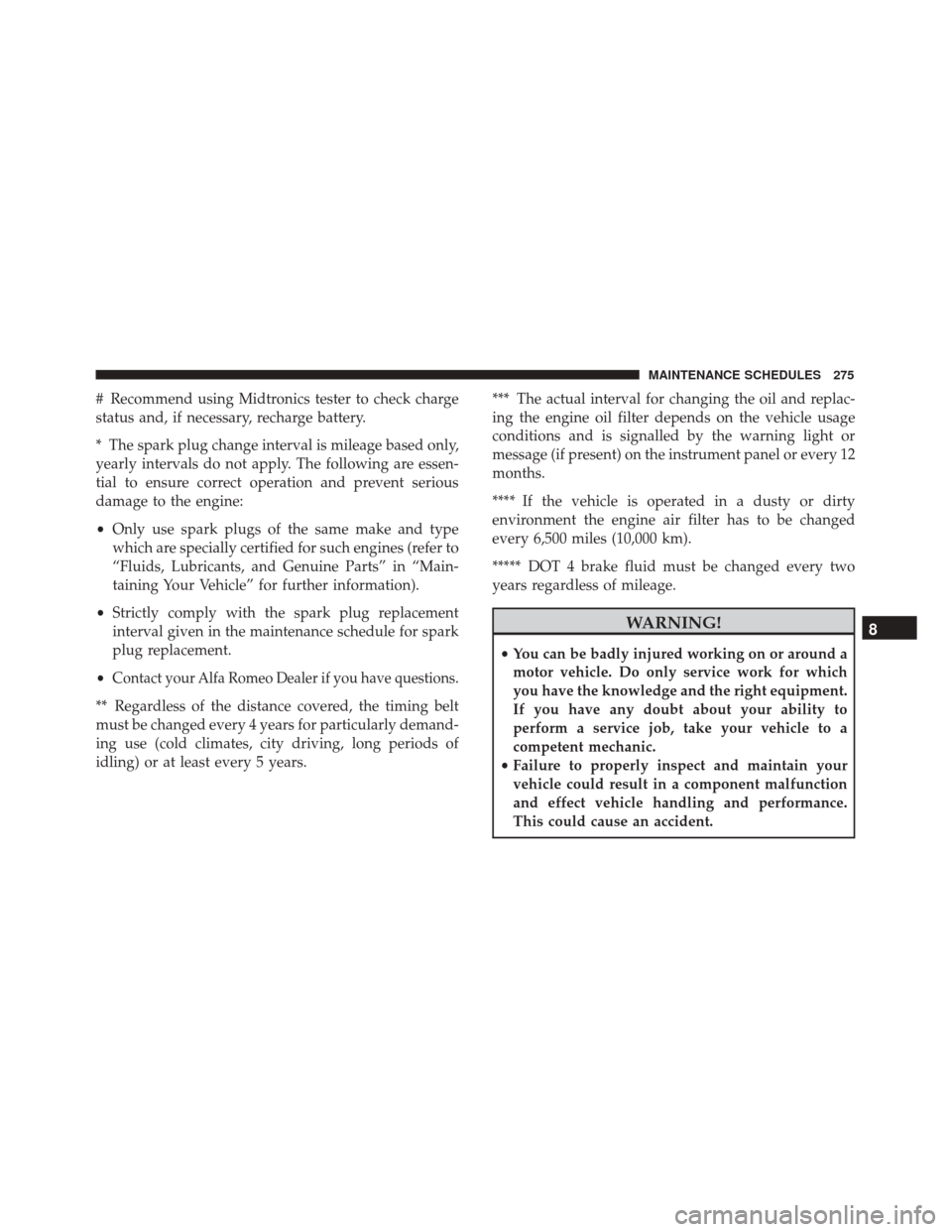
# Recommend using Midtronics tester to check charge
status and, if necessary, recharge battery.
* The spark plug change interval is mileage based only,
yearly intervals do not apply. The following are essen-
tial to ensure correct operation and prevent serious
damage to the engine:
•Only use spark plugs of the same make and type
which are specially certified for such engines (refer to
“Fluids, Lubricants, and Genuine Parts” in “Main-
taining Your Vehicle” for further information).
• Strictly comply with the spark plug replacement
interval given in the maintenance schedule for spark
plug replacement.
• C
ontact your Alfa Romeo Dealer if you have questions.
** Regardless of the distance covered, the timing belt
must be changed every 4 years for particularly demand-
ing use (cold climates, city driving, long periods of
idling) or at least every 5 years. *** The actual interval for changing the oil and replac-
ing the engine oil filter depends on the vehicle usage
conditions and is signalled by the warning light or
message (if present) on the instrument panel or every 12
months.
**** If the vehicle is operated in a dusty or dirty
environment the engine air filter has to be changed
every 6,500 miles (10,000 km).
***** DOT 4 brake fluid must be changed every two
years regardless of mileage.
WARNING!
•
You can be badly injured working on or around a
motor vehicle. Do only service work for which
you have the knowledge and the right equipment.
If you have any doubt about your ability to
perform a service job, take your vehicle to a
competent mechanic.
• Failure to properly inspect and maintain your
vehicle could result in a component malfunction
and effect vehicle handling and performance.
This could cause an accident.
8
MAINTENANCE SCHEDULES 275
Page 287 of 297
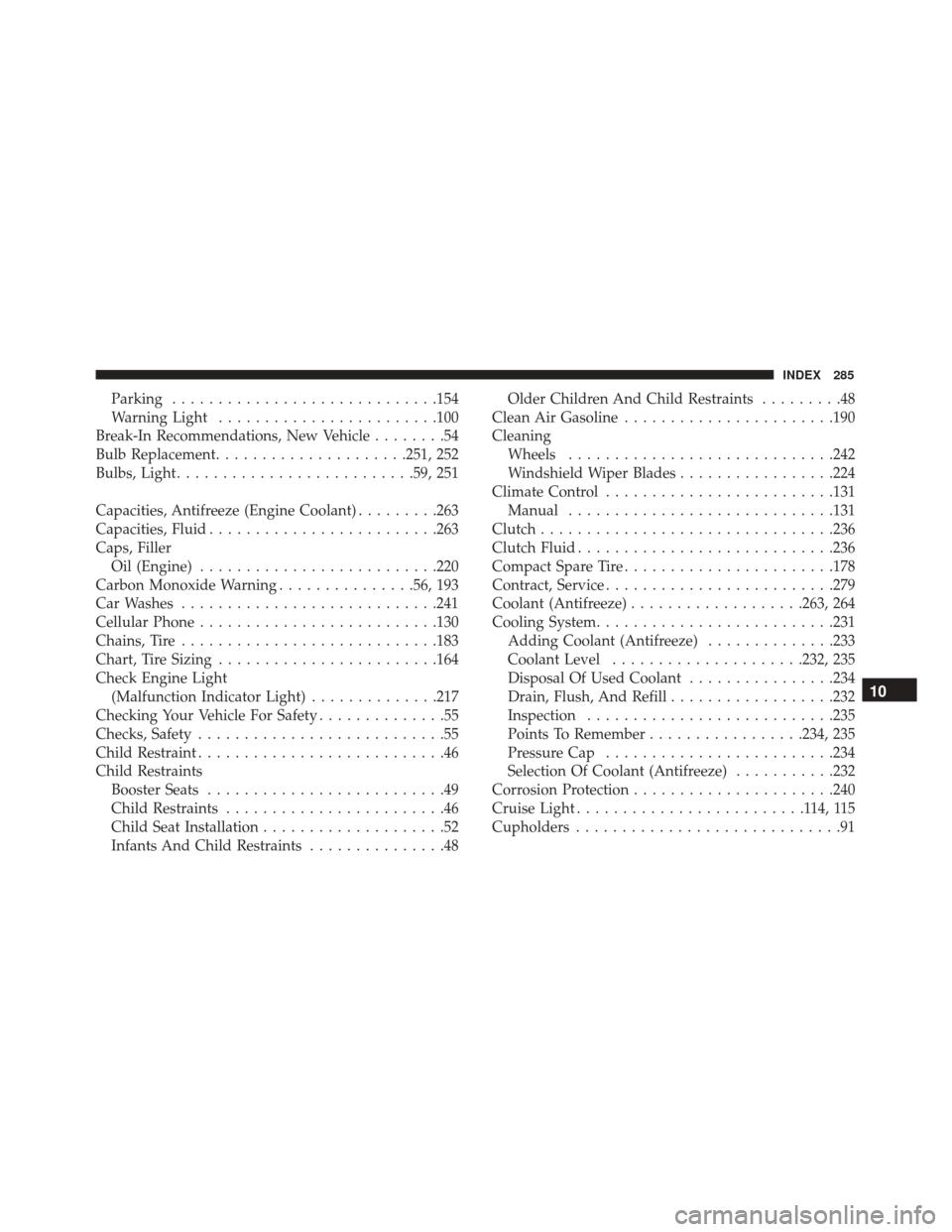
Parking............................ .154
Warning Light ........................100
Break-In Recommendations, New Vehicle ........54
Bulb Replacement .....................251, 252
Bulbs, Light ..........................59, 251
Capacities, Antifreeze (Engine Coolant) .........263
Capacities, Fluid ........................ .263
Caps, Filler Oil (Engine) ..........................220
Carbon Monoxide Warning ...............56, 193
Car Washes ............................241
Cellular Phone ..........................130
Chains, Tire ............................183
Chart, Tire Sizing ........................164
Check Engine Light (Malfunction Indicator Light) ..............217
Checking Your Vehicle For Safety ..............55
Checks, Safety ...........................55
Child Restraint ...........................46
Child Restraints Booster Seats ..........................49
Child Restraints ........................46
Child Seat Installation ....................52
Infants And Child Restraints ...............48Older Children And Child Restraints
.........48
Clean Air Gasoline .......................190
Cleaning Wheels ............................ .242
Windshield Wiper Blades .................224
Climate Control ........................ .131
Manual ............................ .131
Clutch ............................... .236
Clutch Fluid ............................236
Compact Spare Tire .......................178
Contract, Service ........................ .279
Coolant (Antifreeze) ...................263, 264
Cooling System ..........................231
Adding Coolant (Antifreeze) ..............233
Coolant Level .....................232, 235
Disposal Of Used Coolant ................234
Drain, Flush,
And Refill ..................232
Inspection .......................... .235
Points To Remember .................234, 235
Pressure Cap ........................ .234
Selection Of Coolant (Antifreeze) ...........232
Corrosion Protection ..................... .240
Cruise Light .........................114,115
Cupholders .............................9110
INDEX 285
Page 288 of 297
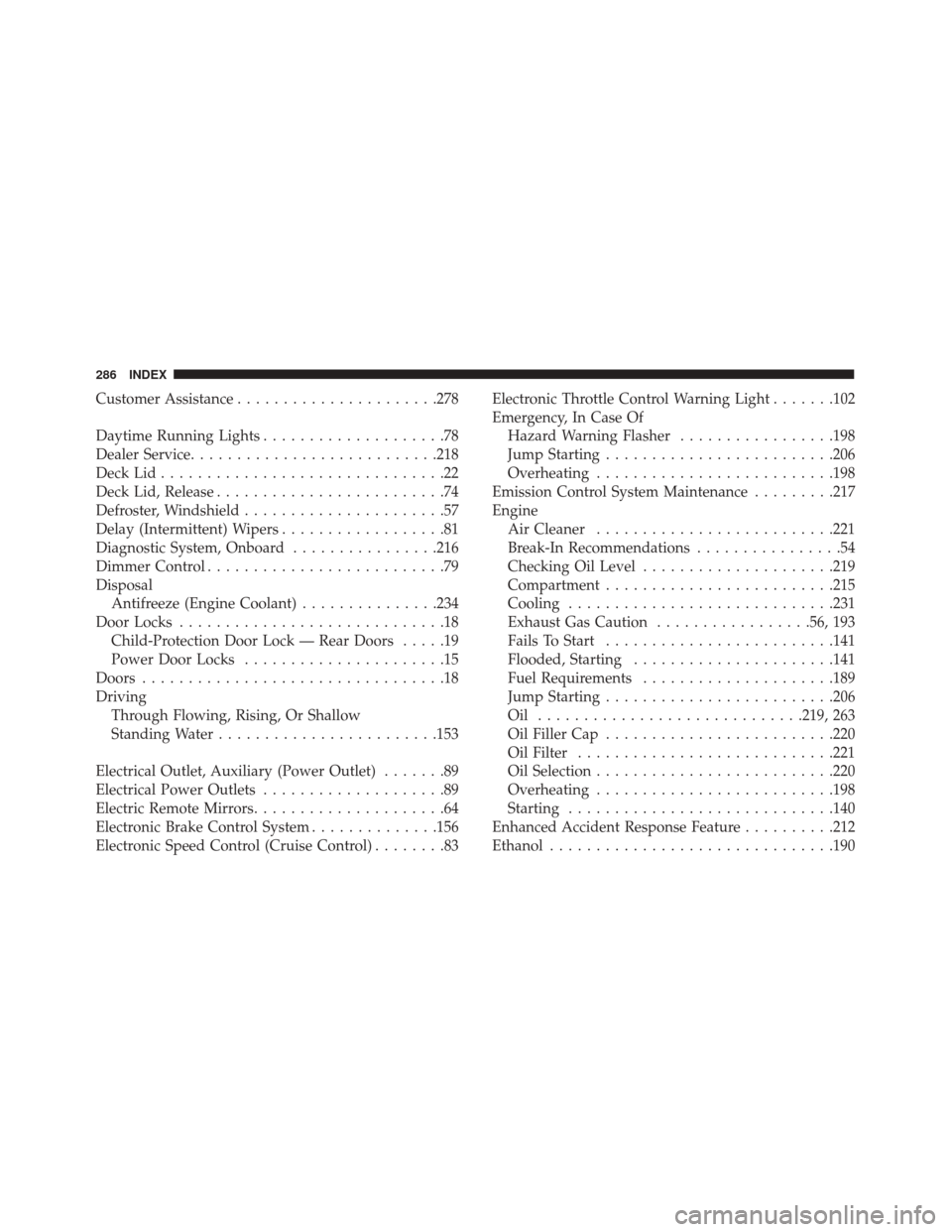
Customer Assistance..................... .278
Daytime Running Lights ....................78
Dealer Service .......................... .218
Deck Lid ...............................22
Deck Lid, Release .........................74
Defroster, Windshield ......................57
Delay (Intermittent) Wipers ..................81
Diagnostic System, Onboard ................216
Dimmer Control ..........................79
Disposal Antifreeze (Engine Coolant) ...............234
Door Locks .............................18
Child-Protection Door Lock — Rear Doors .....19
Power Door Locks ......................15
Doors .................................18
Driving Through Flowing, Rising, Or Shallow
Standing Water ........................153
Electrical Outlet, Auxiliary (Power Outlet) .......89
Electrical Power Outlets ....................89
Electric Remote Mirrors .....................64
Electronic Brake Control System ..............156
Electronic Speed Control (Cruise Control) ........83Electronic Throttle Control Warning Light
.......102
Emergency, In Case Of Hazard Warning Flasher .................198
Jump Starting ........................ .206
Overheating ..........................198
Emission Control System Maintenance .........217
Engine Air Cleaner ..........................221
Break-In Recommendations ................54
Checking Oil Level .....................219
Compartment ........................ .215
Cooling ............................ .231
Exhaust Gas Caution .................56, 193
Fails To Start ........................ .141
Flooded, Starting ..................... .141
Fuel Requirements .....................189
Jump Starting ........................ .206
Oil .............................219, 263
Oil Filler Cap ........................ .220
Oil Filter ............................221
Oil Selection ..........................220
Over
heating ..........................198
Starting ............................ .140
Enhanced Accident Response Feature ..........212
Ethanol ...............................190
286 INDEX